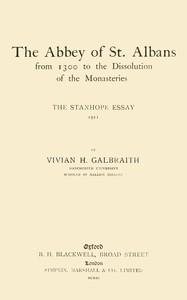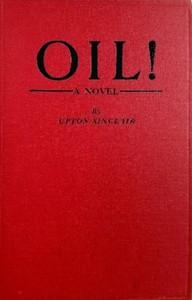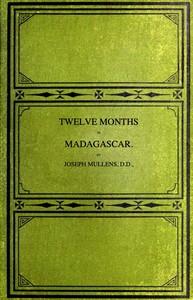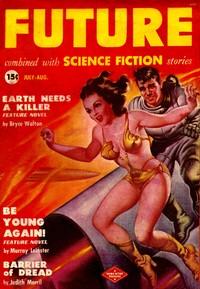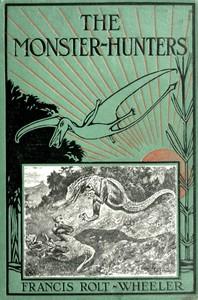|
|
Read this ebook for free! No credit card needed, absolutely nothing to pay.Words: 17844 in 7 pages
This is an ebook sharing website. You can read the uploaded ebooks for free here. No credit cards needed, nothing to pay. If you want to own a digital copy of the ebook, or want to read offline with your favorite ebook-reader, then you can choose to buy and download the ebook.

: The Abbey of St. Albans from 1300 to the dissolution of the monasteries by Galbraith V H Vivian Hunter - St. Albans Abbey; Monasticism and religious orders England St. Albans History Middle Ages 600-1500; Monastic and religious life England St. Albans Hist@FreeBooksThu 08 Jun, 2023 Thus when Abbot Michael, having been struck down by the Black Death, was succeeded by Thomas de la Mare, the foundations of reform had been laid. It fell to the lot of the new abbot to complete and adorn the work begun by his predecessors. Thomas de la Mare, who ruled the Abbey for almost fifty years, has perhaps left a deeper mark on the history of St. Albans than any other abbot. He was no mere political prelate. For his age he was what would be called a good man; but before all things he was an able administrator and a stern though just ruler. Indefatigable in upholding the convent's rights against every outside power, he knew no compromise in his exaction of full obedience from all within the House. To his biographer, credulity, the employment of unworthy officers and his lavish outlay as President of General Chapters were the only flaws in an otherwise perfect character. No censure is passed upon his craftiness in evading the Statute of Mortmain, nor are certain acts of crude revenge adversely commented upon. Besides supreme ability, he certainly possessed an exceptional personality, and towards the close of his life was regarded almost as a saint by the brethren. The greatest of the later abbots, he has perhaps suffered unduly at the hands of his editor, who conceived of him only 'as that most litigious of abbots ... Thomas de la Mare.' His tenants do not appear to have looked upon him as a tyrant. The orderly character of the revolt of 1381 at St. Albans was in marked contrast with the scenes of pillage and murder at Bury St. Edmunds. The St. Albans tenants rose to assert their rights--the men of Bury to avenge their wrongs. Abbot Thomas displayed an astonishing activity in every department of monastic life. The church services were entirely revised, and particular care was bestowed upon the singing, for the regulation of which the Abbot drew up a new ordinal. A series of practical reforms followed; in monastery and cells the discipline was more strictly enforced. The general raising of the monastic standard was exemplified by his refusal to admit illiterate nuns into the house of St. Mary de Prez, and by his careful provisions regulating the duties of the Benedictine students at Oxford. At first, indeed, the rigidness of his discipline caused many of the monks to grumble, and some even to secede. But his method was effective. Before long the Abbey grew famous, not only in England, but on the Continent, and monks were often sent to St. Albans to be trained in monastic discipline for the benefit of their own houses. Its inability to resist kingly and papal extortion during the thirteenth century left the Abbey in a state of miserable poverty. Financial comfort could be restored only by regulating these exactions. This the abbots appear to have realised, and John of Berkhampstead's new arrangement with the King is the first step towards a remedy of the evil. The existing debt was cancelled, and the Abbey secured possession of the revenues during a vacancy in return for a payment of 1,000 marks. Any advantage which this exclusion of the King's escheator might have conferred upon the Abbey was nullified by the unhappy occurrence of no less than five vacancies between 1290 and 1349. Each of these involved not only the payment of 1000 marks to the King, but a far more serious expenditure to secure papal confirmation. The financial embarrassment of the House surely increased. As a result of a special appeal to the Pope, Abbot Hugh secured a licence to receive special subsidies from the cells in order to lighten the debt. But from papal exactions there was no escape. In vain the Abbot begged to be excused from personal attendance at the Curia. His presence was insisted on; the usual enormous fees were exacted, and a licence to contract a loan to meet the expense thus incurred was the only relief afforded him. Abbot Hugh early became a favourite of Edward II, and the King's lavish endowments might well have served to repair the Abbey's fortunes but for the extensive building operations which were necessary. The church fabric was in a ruinous condition; walls were falling and roofs tumbling in, and Abbot Hugh had little choice but to restore the south side of the church. Small wonder that the debt which was 2,300 marks in 1308 was more than double that sum twenty years later. At the accession of Richard Wallingford the Abbey's condition attracted the notice of the Crown, and a commission was appointed in 1327 to 'inquire by whose negligence the existing defects and dissipation of the Abbey's revenues had been brought about.' Two years later Abbot Richard received permission to live abroad for three years 'to avoid the burden of too great expense.' In this unsatisfactory condition the Abbey finances remained till 1349, when the Black Death visited St. Albans with unusual severity. Abbot Michael and three-fourths of the convent perished, and there is little doubt that the mortality among the Abbey's tenants was high. This catastrophe must have further impoverished the Abbey, and the 1000 marks due to the King on de la Mare's accession could only be paid by instalments. De la Mare realised that the payment to King and Pope of large sums at irregular intervals was fatal to any organisation of the Abbey's finances, and to him is due the credit of having conceived the more workable system of annual contributions. Soon after the outbreak of the Great Schism, a petition was addressed to the Pope, supported by commendatory letters from the King, John of Gaunt, Princess Joanna, and the Archbishop of Canterbury. The Abbot prayed that in return for an annual payment of twenty marks the election of succeeding abbots should receive confirmation without their personal attendance at Rome. The arguments which the envoys to Rome were to employ in the hope of winning the Pope's consent to the proposed measure show clearly the difficulties of the Abbey at this time. The whole annual revenue had fallen to ?1,053. Of this, ?465 was assigned to the Abbot--'and to the said Abbot pertains the entertainment of noble guests and of all laymen, and the prosecution of pleas in the various royal courts; which, inasmuch as laymen are more hostile to monks than they were wont, are more expensive than formerly, and also occur more frequently.' The remaining ?600 was considered inadequate for the maintenance of the convent. Hospitality, it appeared, was the greatest burden the Monastery had to bear. 'Also the Lord Pope is to be informed that the Monastery of St. Albans is near London, where the King's Parliaments, Convocation, and other assemblies of nobles and clergy are held. And the nobles and magnates of the realm, both on their journey there and on their return, are entertained at the Abbey, to its great expense and loss.' The dearness of provisions, owing to the proximity of rich neighbours, had also helped to impoverish the Abbey, and finally, the partial felling of its woods to pay its debts to the King and Roman Court had diminished a former source of income. The weakness of the central power during Richard II's minority had offered a favourable opportunity for making a similar arrangement with the Crown. In lieu of a payment of 1,000 marks in each vacancy, Abbot Thomas had induced the Government to accept an annual tribute of fifty marks. Half a century earlier such measures might have completely restored the Abbey's finances, and even during the fifteenth century they sensibly lessened its embarrassment. More they could not do, for the decay of the economic system was to make prosperity impossible. This detached political attitude is one reason why monastic chronicles are often so intolerably dull. Yet politics were as keen and as absorbing in the Middle Ages as they are now, and monks and Abbot must have followed their course, and criticised the actors, with as much freedom as the men of to-day. In favour of St. Albans it must be said that, in comparison with other monasteries, its chronicles are singularly living and human. In those written during the revival of historical writing under the guidance of Thomas Walsingham, the political sympathies of the convent during the critical period of Richard II's reign are fully revealed. Towards Richard II their feelings were hostile, if not contemptuous. Walsingham, in his history of the reign, describes with unction the King's childish behaviour during his fits of ungovernable anger, his violent words on more than one occasion to his Parliaments, and his absurd extravagance in dress. With righteous indignation he relates how Richard, on his way to London, borrowed from the monastery a palfrey, which he never returned. Another chronicler tells with scorn of the King's visit to the Abbey in 1394, when large concessions were promised, but never fulfilled. De la Mare's successor, John Moote, was apparently on equally indifferent terms with the King. 'This Abbot,' says the chronicler, 'gave to King Richard for the purpose of preserving his good will and avoiding his malice, at different times, one hundred and twenty-six pounds, thirteen shillings and four pence.' Free books android app tbrJar TBR JAR Read Free books online gutenberg More posts by @FreeBooks
: Oil! by Sinclair Upton - Political fiction; Motion picture industry Fiction; Petroleum industry and trade Fiction; California Southern Fiction@FreeBooksThu 08 Jun, 2023

: Twelve months in Madagascar by Mullens Joseph - Madagascar Description and travel@FreeBooksThu 08 Jun, 2023
|
Terms of Use Stock Market News! © gutenberg.org.in2025 All Rights reserved.

